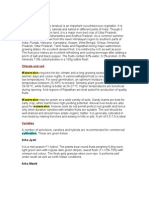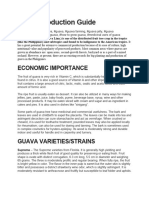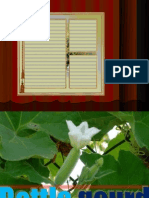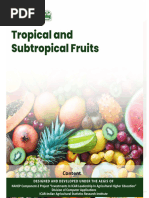7 Cultivation of Guava
7 Cultivation of Guava
Uploaded by
minulimahanamaCopyright:
Available Formats
7 Cultivation of Guava
7 Cultivation of Guava
Uploaded by
minulimahanamaOriginal Title
Copyright
Available Formats
Share this document
Did you find this document useful?
Is this content inappropriate?
Copyright:
Available Formats
7 Cultivation of Guava
7 Cultivation of Guava
Uploaded by
minulimahanamaCopyright:
Available Formats
Guava – Psidium guajava
Family- Myrtaceae
Origin & Distribution
Native to tropical regions of North & South America
Cultivated extent of guava is 1,287 ha in Sri Lanka.
Botany
It is a shallow rooted, small tree or a shrub
Reaches to 30 feet (9 m) height.
Greenish brown bark, peeling off in thin flakes.
Have large, opposite, oblong leaves, finely pubescent, 5-15 cm long & 3-7
cm wide.
Flowers are axillary, 2.5 -3cm in diameter with either solitary or flowers in
groups of 2-3, stamens are numerous, inserted in rows in the disc, Small,
white flowers, filaments are white, anthers pale yellow,
Fruit is spherical or pear shaped, 2-4 inches in diameter.
Fruit is a berry; thick pericarp & fleshy seed cavity. Fruits are soft when
ripened; interior of fruit is white, pink or red.
Guava is pear shaped tropical fruits
with pinkish flesh & yellow skin.
Economical importance
As a fresh fruit.
Industrial products -Fruit juices, jam, cordials, jelly.
Desert in fruit salad.
Rich in dietary fiber, Vit. A & C, minerals- calcium, phosphorus &
potassium.
Recommended varieties
Bangkok Giant- White guava cultivar, native to tropical Asia, a large fruit.
Horana red- oval shaped, red flesh, weight of a fruit- 200g, yield 45
kg/tree/year.
Horana white- more sweeter, round shape, white flesh, weight per fruit is
230 g, yield 50 kg/tree/year.
Pubudu- Sweet, white flesh, weight of a fruit is 800g, yield 50 kg/tree/year.
Kanthi- Round shape with white flesh, weight per fruit is 350 g, yield 45 kg/
tree/ year, a dwarf variety.
Climate
Annual rain fall 1000-4000mm.
The rains during the harvesting period, deteriorate the quality of the fruit.
Temperature 23- 280 C. Can tolerate temperature upto 450 C.
Elevation- 1500- 2000m (suitable for all 3 zones).
Tolerance to drought condition.
Soil
Sandy to clay loam.
Wide range of soil PH 4.5- 9.0.
Slight tolerance to salinity &water logging.
Seed propagation
Propagation through seeds should not be encouraged because
seedlings have long juvenile phase & give low yield & bear low
quality fruits.
Vegetative Propagation
Patch budding (commonly used).
Modified forkette budding.
Modified patch budding method practiced for guava.
A patch size approximately 1cm x 1.5 cm seems to take better than
when a small patch or bud is used.
Buds on brown stems with leaf scars hard and grown over are better to
use than younger buds with leaf scars still distinct & soft.
Shield budding
Air layering
After the bending the plant, it’s branches are covered with soil
leaving the terminal portion is opened.
In a few months, the rooting of branches take place which are the
separate from the mother plant & plant in a nursery bed.
Limited number of plants can be multiplied from a other plant.
Planting
Size of planting holes- 60 cm x 60 cmx60cm.
Spacing- 4.5- 5.0 m x 4.5- 5.0m.
The holes should be filled with farm yard manure& soil.
Mulching
During dry spells, improve the fruit size.
Training & Pruning
Traditionally no pruning is done.
But no pruning results are formation of narrow canopy, limb breakages due
to heavy fruit load & overcrowding.
3-4 well spaced branches, arising at 60 cm above the ground level are
maintained.
The trees should be maintained at a 3m height to facilitate harvesting &
build a strong framework.
Weeding
Tall weeds can be removes by hand.
Legumes crops can be intercropped during first 3 years of planting to obtain
high yield.
Surface mulching.
Mowing- This method is a very expensive because the weeds at the base of
the trees will consume large portion of applied fertilizer. Therefore applied
amount of fertilizer may be increased.
Chemical wed control.
Irrigation
This crop is mostly grown under rain fed condition & rarely practiced under
irrigated condition.
Irrigation help to increase the crop vigor & fruit set.
Irrigation is especially desirable after planting for survival of plants and
thereafter for 2-3 years to obtain early good growth.
The fruit quality of guava adversely affected by high soil moisture content
during harvesting.
Harvesting
Fruiting starts 2- 2.5 years old (budded plants).
120 -150 days take to fruit maturity.
The trees beginning bearing 3-4 years but they attain full bearing capacity at
the age of 8-10 years.
Guava develops best flavor & aroma only when they ripen on trees.
For local market fully yellow but firm fruits are harvested.
Half yellow fruits are harvested to transport distant markets.
Fruits are harvested selectively by hand along with stalk & leaves (stimulate
the growth of flush with flowers).
Yield
Bangkok - 22 t/ha/yr.
Pubudu- 20t/ha/yr.
Horana white- 20 t/ha/yr.
Horana red- 17.9 t/ha/yr.
Kanthi- 20 t/ha/yr.
Post – harvest techniques
Fruits are packed in baskets made from locally available plant materials.
For distant market, wooden or fiber boxes along with good cushion materials
– paddy straw, dry grass, guava leaves or rough papers are used.
Guava is a delicate fruit, requiring careful handling during harvesting &
transporting.
Since fruits are sold at cheaper prices & are available in the long period of
the year, they are not kept in the storage.
However shelf life period of guava can be extended up to 20 days by
keeping them at low temperature of 50 C & 80-85 RH.
It can be stored in the room temperature (18-230 C) at about 10 days in
ventilated poly bags.
You might also like
- Ehl Grade 12 P2 Jit BookletDocument133 pagesEhl Grade 12 P2 Jit BookletkwanodkuhleNo ratings yet
- Watermelon Production TrainingDocument25 pagesWatermelon Production TrainingPrincess Ruth MangenaNo ratings yet
- Pechay Production GuideDocument23 pagesPechay Production GuideMajorineNo ratings yet
- Introduction Watermelon (Citrullus Lanatus) Is An ImportantDocument9 pagesIntroduction Watermelon (Citrullus Lanatus) Is An ImportantparmardhavalNo ratings yet
- Guava Production GuideDocument7 pagesGuava Production GuideErwin SesioNo ratings yet
- GuavaDocument8 pagesGuavaGary Bhullar100% (2)
- 3cultivation of RAMBUTANDocument2 pages3cultivation of RAMBUTANminulimahanamaNo ratings yet
- Lecture 27 RambutanDocument5 pagesLecture 27 RambutanGopu ChiyaanNo ratings yet
- Brinjal / Egg PlantDocument4 pagesBrinjal / Egg Plantdevanshkatiyar122No ratings yet
- PomegranateDocument21 pagesPomegranateDr.Eswara Reddy Siddareddy50% (2)
- Bottle GourdDocument67 pagesBottle GourdDr.Eswara Reddy Siddareddy100% (1)
- AonlaDocument4 pagesAonlawasteid092No ratings yet
- Pawpaw 1Document4 pagesPawpaw 1stanlausmulupi47No ratings yet
- HC35 Lesson 12 LContentDocument10 pagesHC35 Lesson 12 LContentappeteemarose4No ratings yet
- Production Guide On SquashDocument5 pagesProduction Guide On SquashAlex Matanog JumamoyNo ratings yet
- Minor VegetablesDocument11 pagesMinor VegetablesMonikagaireNo ratings yet
- L19. Hort181 - Ber JamunDocument8 pagesL19. Hort181 - Ber JamunAmit GoenkaNo ratings yet
- PapayaDocument7 pagesPapayaRyan MorillaNo ratings yet
- Fruit BearingDocument41 pagesFruit BearingWendz GatdulaNo ratings yet
- Methods of Arecanut CultivationDocument33 pagesMethods of Arecanut Cultivationসপ্তক মন্ডলNo ratings yet
- Jack FruitDocument5 pagesJack Fruitnesitathounaojam1No ratings yet
- Peanut Butter TreeDocument6 pagesPeanut Butter TreeKrizza Nica ParumNo ratings yet
- Passion Fruit PDFDocument14 pagesPassion Fruit PDFamuronegaduNo ratings yet
- Passion Fruit Farming: Yellow Passion Variety Purple Passion VarietyDocument7 pagesPassion Fruit Farming: Yellow Passion Variety Purple Passion VarietyShan Maya100% (1)
- GuavaDocument15 pagesGuavakarambajwa04No ratings yet
- CherriesDocument50 pagesCherriesShreyaNo ratings yet
- Papaya Cultivation 056Document17 pagesPapaya Cultivation 056Sudhangsu Bhaumik100% (1)
- Guyabano ProductionDocument8 pagesGuyabano ProductionCharlie Uy100% (1)
- PASSION FRUIT PRODUCTION (1)Document8 pagesPASSION FRUIT PRODUCTION (1)moding daveNo ratings yet
- pERENNIAL EDIBLE FRUITS OF THE TROPICSDocument29 pagespERENNIAL EDIBLE FRUITS OF THE TROPICSjavier rodriguezNo ratings yet
- AmorphophallusDocument7 pagesAmorphophallussubhalaxmisubhu361No ratings yet
- lec2wDocument5 pageslec2wDeva Ganga SlideshareNo ratings yet
- Cucumber: C. Anguria L. (West Indian Gherkin)Document12 pagesCucumber: C. Anguria L. (West Indian Gherkin)tummalaajaybabuNo ratings yet
- Rose AppleDocument3 pagesRose Appledany manojNo ratings yet
- Okra Me - 020111 VBZCBDocument7 pagesOkra Me - 020111 VBZCBUday ShahNo ratings yet
- 8 Cultivationof AmbarallaDocument2 pages8 Cultivationof AmbarallaminulimahanamaNo ratings yet
- French Bean 020148Document6 pagesFrench Bean 020148Uday ShahNo ratings yet
- BerDocument4 pagesBerdeepakNo ratings yet
- Ash Gourd and Bottle Gourd OnlineDocument11 pagesAsh Gourd and Bottle Gourd OnlineLipsa PadhanNo ratings yet
- Forestry Wasteland - NeemDocument8 pagesForestry Wasteland - NeemVipul SuranaNo ratings yet
- CassavaDocument5 pagesCassavaAlduin Pelotos AsiaNo ratings yet
- Avocado FarmingDocument8 pagesAvocado FarmingRajaBadaNo ratings yet
- SapotaDocument17 pagesSapotaKishu KishorNo ratings yet
- Phil Veg GrowingDocument86 pagesPhil Veg GrowingManny QuibinitNo ratings yet
- Neem Cultivation-457Document9 pagesNeem Cultivation-457mandaremNo ratings yet
- AONLADocument31 pagesAONLAN RosanNo ratings yet
- Sapota CultivationDocument44 pagesSapota CultivationN RosanNo ratings yet
- L14. Hort181 - GuavaDocument4 pagesL14. Hort181 - GuavaAmit Goenka100% (1)
- 13.SARPAGANDHADocument4 pages13.SARPAGANDHAN RosanNo ratings yet
- Specialty Crop Profile: Pawpaw: Tony Bratsch, Extension Specialist, Small Fruit and VegetablesDocument3 pagesSpecialty Crop Profile: Pawpaw: Tony Bratsch, Extension Specialist, Small Fruit and VegetablesfodoNo ratings yet
- WatermelonDocument2 pagesWatermelonpetah_9No ratings yet
- RidgeDocument10 pagesRidgeRaghaNo ratings yet
- PeaDocument8 pagesPeaKiran K KhanapuriNo ratings yet
- Taiwan Guava Production Manual: First EditionDocument40 pagesTaiwan Guava Production Manual: First EditionCarlos Hernandez100% (5)
- Avocado ProductionDocument5 pagesAvocado Productionemasenick001No ratings yet
- JackfruitDocument28 pagesJackfruitN RosanNo ratings yet
- Guava Cultivation Practices-SereddyDocument68 pagesGuava Cultivation Practices-SereddyDr.Eswara Reddy Siddareddy100% (2)
- L12. Hort181 - PapayaDocument5 pagesL12. Hort181 - PapayaAmit GoenkaNo ratings yet
- Growing the Stone Fruits - With Information on Growing Cherries, Peaches and PlumsFrom EverandGrowing the Stone Fruits - With Information on Growing Cherries, Peaches and PlumsNo ratings yet
- Three Articles on Growing Currants and Gooseberries - Including Information on Propagation, Planting, Pruning, Pests, VarietiesFrom EverandThree Articles on Growing Currants and Gooseberries - Including Information on Propagation, Planting, Pruning, Pests, VarietiesNo ratings yet
- Aviation Meteorology TestDocument7 pagesAviation Meteorology TestayushNo ratings yet
- National Security Concerns: National Service Training Program Lucban, QuezonDocument4 pagesNational Security Concerns: National Service Training Program Lucban, QuezonAlexs VillafloresNo ratings yet
- Udyam Registration Certificate: TradingDocument1 pageUdyam Registration Certificate: TradingGAURAV BHARDWAJNo ratings yet
- 7296 0110 IMP Multi Point Inspection Form Toyota 1Document40 pages7296 0110 IMP Multi Point Inspection Form Toyota 1Santiago EspinosaNo ratings yet
- 62 Sundance Pollen TrapDocument7 pages62 Sundance Pollen TrapAllan Z McMakenNo ratings yet
- Forms PDFDocument351 pagesForms PDFNeelanjan ChakrabortyNo ratings yet
- MSA1K-3113NA Produc DesctDocument4 pagesMSA1K-3113NA Produc DesctAkm AnisuzzamanNo ratings yet
- Task 2 TopicsDocument15 pagesTask 2 TopicsfidaNo ratings yet
- DSE 8610 Installation Instructions PDFDocument124 pagesDSE 8610 Installation Instructions PDFPaulo MandingaNo ratings yet
- Tally-Access-eFiling AssignmentDocument10 pagesTally-Access-eFiling AssignmentAman NayakNo ratings yet
- Kruss Bro Dfa100 en PDFDocument8 pagesKruss Bro Dfa100 en PDFTravis HNo ratings yet
- Labor MobilityDocument27 pagesLabor MobilityIqbal ChyNo ratings yet
- Intellectual Property Rights For BiotechnologyDocument9 pagesIntellectual Property Rights For BiotechnologyAlfa ChauhanNo ratings yet
- Freebsd Full Disk Encryption, With An External Boot Drive, Geli, and UfsDocument9 pagesFreebsd Full Disk Encryption, With An External Boot Drive, Geli, and UfsAlexandre PereiraNo ratings yet
- Đề kiểm tra anh 10 Global có file nghe END-OF-TERM TEST 1 (Semester 1)Document16 pagesĐề kiểm tra anh 10 Global có file nghe END-OF-TERM TEST 1 (Semester 1)Thanh Xuân Nguyễn100% (1)
- Lgko/Kgs: 1.1. Atis 1.2. Taxi ProceduresDocument22 pagesLgko/Kgs: 1.1. Atis 1.2. Taxi ProceduresMido ZezoNo ratings yet
- 仪器的接线图Document6 pages仪器的接线图17861166770aNo ratings yet
- Contoh Proposal Pembangunan Jalan Desa PDFDocument1 pageContoh Proposal Pembangunan Jalan Desa PDFCokro SuharyoNo ratings yet
- Heat Exchanger (Catia)Document50 pagesHeat Exchanger (Catia)Venkatesh Kollisetti100% (1)
- Investor Diary Beginner Stock Analysis Excel (V-1) : How To Use This Spreadsheet?Document56 pagesInvestor Diary Beginner Stock Analysis Excel (V-1) : How To Use This Spreadsheet?SumitNo ratings yet
- LOLERDocument8 pagesLOLERNofrizal NofrizalNo ratings yet
- Balbir Pasha Ko AIDS Hoga KyaDocument6 pagesBalbir Pasha Ko AIDS Hoga Kyaravichess6669100% (1)
- Comparasion Product Elvatech HandHeld XRFDocument6 pagesComparasion Product Elvatech HandHeld XRFditya dewanggaNo ratings yet
- JFGJGDocument11 pagesJFGJGKaiza PonesNo ratings yet
- Download Full (Original PDF) Positive Learning Environments Creating and Maintaining Productive Classrooms 1 PDF All ChaptersDocument55 pagesDownload Full (Original PDF) Positive Learning Environments Creating and Maintaining Productive Classrooms 1 PDF All Chapterslesramteley100% (1)
- Chemical Composition of The EarthDocument58 pagesChemical Composition of The EarthPutik Nurul ArasyNo ratings yet
- Introduction To LiturgyDocument43 pagesIntroduction To LiturgyChristopher Dela cruz100% (2)
- What Is EasterDocument6 pagesWhat Is EasterSanja HelixNo ratings yet
- Bullying Is NefariousDocument2 pagesBullying Is NefariousSEYALIERY COZENSNo ratings yet

























































































